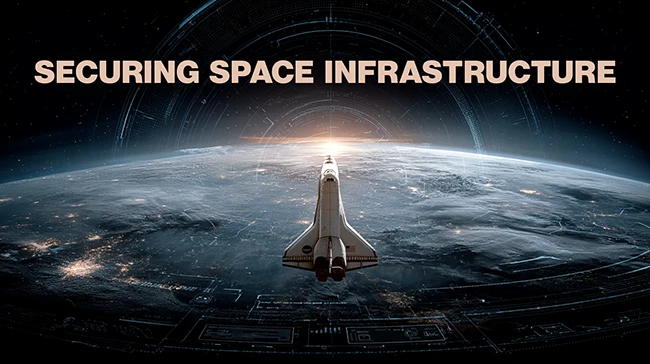
As the space sector becomes more commercial and military-focused, these assets are becoming attractive targets. The global space economy is booming and is expected to increase from $630 billion in 2023 to $1.8 trillion by 2035. This means the need to protect space infrastructure from cyber threats will only grow larger and more complex.

Why space systems are vulnerable
There are around 11,700 active satellites currently orbiting Earth , and with more commercial players entering the space arena, that number is expected to grow. Private companies are redefining the frontier of space exploration, while also wading into geopolitical and security waters.
With these firms expanding their technological reach and developing innovations that serve both peaceful and defensive ends, the once-distinct lines separating civilian, commercial, and military operations in space are becoming blurred.
These assets provide services like telecommunications, GPS, and finance, so a cyberattack on any part of the network, such as satellites, ground stations, data links, or user terminals, could cause serious problems.
While there are several potential risks, a few stand out as particularly critical, such as:
Remote locations: Satellites and spacecraft can’t be repaired or upgraded once they’re in orbit. If a system is launched with a flaw, it may remain vulnerable for the rest of its operational life. The physical distance also makes it harder to detect problems quickly or respond in real time.
Aging equipment: Satellites are usually designed to operate for 15 to 20 years. Over time, their hardware and software can become outdated. Security methods that worked at launch may no longer be effective against recent attack techniques. This includes encryption methods that grow weaker as computing capabilities increase.
Global exposure: Space systems can be accessed from almost anywhere on Earth, which makes them more exposed to attack than systems limited by geography. Many satellite signals are transmitted openly, which means they can be intercepted or disrupted using equipment that is widely available and relatively inexpensive.
Complexity: Space is a borderless environment with many different operators, each with their own priorities, rules, and ways of handling cybersecurity. This makes it hard to organize a unified defense. In addition, all these players depend on connected supply chains that cover everything from manufacturing to launch and day-to-day operations. Every part of these supply chains, especially third-party vendors, can bring in cyber risks.
Risks in the ground segment
The ground segment of space systems includes ground stations, command centers, data processing units, and user terminals that manage and monitor satellites via terrestrial networks. These components use antennas, communication equipment, and support systems to operate smoothly.
Cyber risks affecting them include network exploitation, outdated software, data tampering, and physical access breaches. Similar to attacks on regular enterprise networks, cyberattacks on space systems often use tactics like exploiting misconfigurations and software weaknesses. Attackers try to gain unauthorized access to critical services, inject malware, or use phishing to steal sensitive credentials.
Security researcher Leon Juranić discovered a vulnerability in NASA’s open-source software that could have potentially compromised computer systems within the agency.
The data breach at space tech giant Maxar shows that such security gaps are far from rare.
Geopolitical tensions
With geopolitical tensions, space could easily turn into the next battleground for global powers, potentially involving attacks on satellites or other key space assets.
Erin Miller, the executive director at Space ISAC, warned that most space companies would have a difficult time defending against well-orchestrated cyberattacks by a nation-state.
A cyberattack on American satellite internet provider Viasat knocked out internet service for tens of thousands of satellite modems in Ukraine and elsewhere in Europe. In a recent incident, the Polish Space Agency (POLSA) confirmed a cyberattack hit its systems, forcing it to take its network offline.
All of this points to a new era of cyberattacks, one that will unfold not only on Earth but also in space.
Regulatory challenges
Despite how advanced the space industry is and how much we rely on space infrastructure, cybersecurity often gets overlooked, both by those running the systems and by the policymakers who should be regulating them.
Take the U.S., for example. Even though it is a major space player, it has not officially labeled the space tech sector as critical infrastructure and has made little progress in enforcing mandatory cybersecurity rules to protect it.
One of the main efforts to improve cybersecurity is Space Policy Directive-5 (SPD-5), a presidential memo from 2020. It lays out voluntary principles for keeping space systems secure, such as risk-based engineering, protecting against threats like unauthorized access and jamming, and encouraging industry collaboration based on specific mission needs.
In terms of standardization, the U.S. National Institute of Standards and Technology (NIST) offers resources aimed at helping the commercial satellite industry assess and manage cybersecurity risks. One key publication, “Introduction to Cybersecurity for Commercial Satellite Operations,” focuses specifically on this sector’s risk management.
Additionally, the United States supports space cybersecurity collaboration through the Space Information Sharing and Analysis Center (Space ISAC), which was established in 2019 with backing from NASA, the U.S. Space Force, and the National Reconnaissance Office.
At the EU level, the updated NIS2 Directive, which sets out measures to ensure a high common level of cybersecurity across the Union, now includes space as a critical sector. This covers operators of ground-based infrastructure that support space services, as well as telecommunications providers.
The European Commission recently announced a proposal for the first EU Space Act, which would, among other measures, mandate cybersecurity assessments and incident reporting throughout the satellite lifecycle to bolster Europe’s defenses against cyber threats and hostile disruptions.
Building cyber resilience in space
Building strong cyber resilience in space takes more than just technological advances.
Information sharing and reporting: Given the nature of the space ecosystem, collaboration between governments, the private sector, and academia is essential.
But right now, two main obstacles hold the space industry back from effective cybersecurity collaboration. First, new and still-developing industry standards and regulations create barriers. Second, business concerns shape how companies manage risks, which can complicate sharing. Because of these challenges, it’s often unclear who to partner with or how to coordinate efforts across the industry.
Put security protocols in place to verify the integrity of the entire supply chain, from manufacturers and suppliers all the way to end users. Having security checks throughout the supply chain helps catch and stop cyber threats before they can make their way into bigger systems.
Secure communication protocols: Keeping satellite communications safe is important since they’re a top target for cyberattacks like jamming, interference, and unauthorized access. The systems we have now fall short because of weak password protection and risks from insider threats, so better security is needed. That means relying on strong encryption and trustworthy protocols to securely move data between spacecraft and ground stations, while maintaining a good balance between speed and protection.
Boosting suply chain security: When it comes to keeping things safe and running smoothly, it’s important to work with trusted suppliers you’ve carefully checked out. At the same time, keeping an eye out for fake, fraudulent, or harmful equipment is key to protecting against risks. All of these steps help catch problems early and keep the supply chain secure.
Incident response and recovery: When a cyberattack hits a space mission, it’s crucial to act fast and respond well. This means having plans ready, figuring out what happened, limiting the damage, and collecting evidence. Communication between mission control, system admins, and others is key. The team investigates by checking logs, isolating affected systems, and securing data. Afterward, they fix weaknesses, apply patches, and strengthen security. Learning from the attack helps improve policies and future responses. Regular testing helps the team stay ready for new threats.
Access control management: Since many different people are involved in space missions, a key way to reduce security risks is by managing who can access what. This means putting stronger authentication and access controls in place to make sure only the right people can get to important systems and data.
AI and ML tools: Leverage AI and ML tools, including through onboard systems, to boost cyber awareness across all parts of space operations. These tools can help spot and analyze cyber threats as they happen, allowing teams to respond quickly and stay ahead of problems in the space environment.




